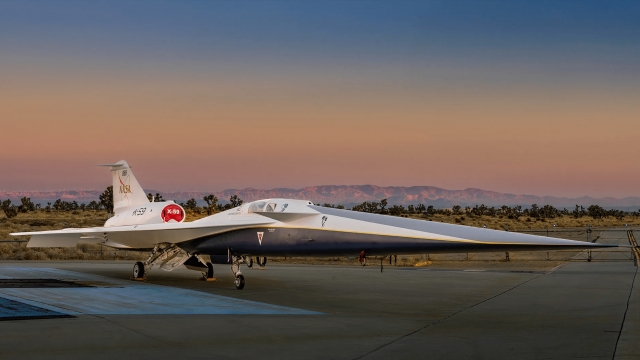If you're a fan of high-tech aircraft, you're going to love this!
A much-awaited unveiling and a promise to revolutionize commercial aviation.
“Today we are witnessing history,” said John Clark, Lockheed Martin Aeronautics vice president.
NASA and Lockheed Martin unveiled their newly painted X-59 quiet supersonic aircraft on Friday.
“An x-plane is a symbol of our collective ambition to redefine the future, and in this case, it's the future of supersonic travel,” said NASA Deputy Administrator Pam Melroy.
NASA's Quesst mission is testing the experimental aircraft to see if it can fly without creating the thunderous sonic booms associated with supersonic flights.
“This groundbreaking technology is a beacon guiding us towards the future where visibility barriers in aircraft design can be overcome with this inventive solution,” said Melroy.
In 1973, the federal aviation administration banned overland supersonic commercial flights because of the disruption caused by those sonic booms.
It's a prohibition that's still in effect today, but NASA hopes the X-59 can overcome that and pave the way for a new generation of commercial aircraft that can travel faster than the speed of sound.
“We also designed special features into the airplane, such as its top-mounted engine with a deck under the nozzle, which ensures that the shockwaves don't merge behind the aircraft and create that disruptive shock below,” said Melroy.
NASA plans to do test flights over U.S. cities in 2026 and ask residents how much noise they can detect from the aircraft.
NASA hopes the data will help it determine if the ban on overland supersonic commercial flights can be lifted.
“The people we're relying on to give us honest, unbiased feedback on the X-59's noise will be the key to getting the data we need for the mission to be a success,” said NASA associate administrator Jim Free.
The aircraft features a sharp, elongated beak-like nose section that helps shape the shock waves the jet produces during flights.
Pilots flying the X-59 can't see out of the plane's forward windscreen because it doesn't have one.
NASA says pilots use an external vision system that has a forward-facing camera, a cockpit-mounted display screen, and custom image processing software to generate "an augmented reality view."
“The external vision system has the potential to influence future aircraft designs where the absence of the forward-facing window may prove advantageous for engineering reasons as it did for us,” said Melroy.
The supersonic jet will reach a speed of Mach 1.4, or 925 mph, while surfing the skies at an altitude of 55 thousand feet, powered by a single engine.
The X-59 has been in the works at Lockheed Martin's "Skunk Works" facility in Palmdale, California, since 2019.
NASA plans its first flight sometime in 2024 and further testing through 2027.
SEE MORE: Moonwalk delayed to 2026; NASA postpones next 2 Artemis missions
Trending stories at Scrippsnews.com



